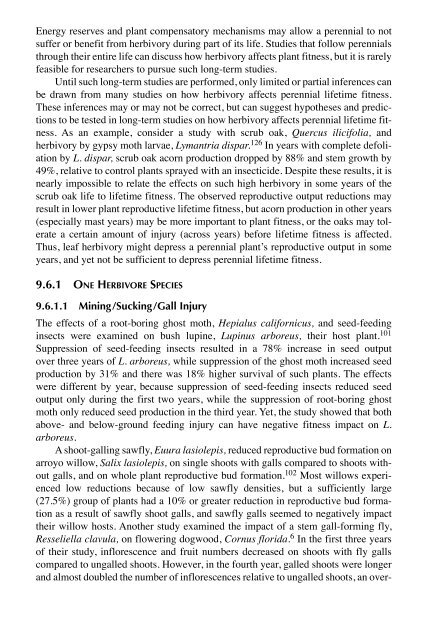Biotic Stress and Yield Loss
Biotic Stress and Yield Loss
Biotic Stress and Yield Loss
- No tags were found...
You also want an ePaper? Increase the reach of your titles
YUMPU automatically turns print PDFs into web optimized ePapers that Google loves.
Energy reserves <strong>and</strong> plant compensatory mechanisms may allow a perennial to notsuffer or benefit from herbivory during part of its life. Studies that follow perennialsthrough their entire life can discuss how herbivory affects plant fitness, but it is rarelyfeasible for researchers to pursue such long-term studies.Until such long-term studies are performed, only limited or partial inferences canbe drawn from many studies on how herbivory affects perennial lifetime fitness.These inferences may or may not be correct, but can suggest hypotheses <strong>and</strong> predictionsto be tested in long-term studies on how herbivory affects perennial lifetime fitness.As an example, consider a study with scrub oak, Quercus ilicifolia, <strong>and</strong>herbivory by gypsy moth larvae, Lymantria dispar. 126 In years with complete defoliationby L. dispar, scrub oak acorn production dropped by 88% <strong>and</strong> stem growth by49%, relative to control plants sprayed with an insecticide. Despite these results, it isnearly impossible to relate the effects on such high herbivory in some years of thescrub oak life to lifetime fitness. The observed reproductive output reductions mayresult in lower plant reproductive lifetime fitness, but acorn production in other years(especially mast years) may be more important to plant fitness, or the oaks may toleratea certain amount of injury (across years) before lifetime fitness is affected.Thus, leaf herbivory might depress a perennial plant’s reproductive output in someyears, <strong>and</strong> yet not be sufficient to depress perennial lifetime fitness.9.6.1 ONE HERBIVORE SPECIES9.6.1.1 Mining/Sucking/Gall InjuryThe effects of a root-boring ghost moth, Hepialus californicus, <strong>and</strong> seed-feedinginsects were examined on bush lupine, Lupinus arboreus, their host plant. 101Suppression of seed-feeding insects resulted in a 78% increase in seed outputover three years of L. arboreus, while suppression of the ghost moth increased seedproduction by 31% <strong>and</strong> there was 18% higher survival of such plants. The effectswere different by year, because suppression of seed-feeding insects reduced seedoutput only during the first two years, while the suppression of root-boring ghostmoth only reduced seed production in the third year. Yet, the study showed that bothabove- <strong>and</strong> below-ground feeding injury can have negative fitness impact on L.arboreus.A shoot-galling sawfly, Euura lasiolepis, reduced reproductive bud formation onarroyo willow, Salix lasiolepis, on single shoots with galls compared to shoots withoutgalls, <strong>and</strong> on whole plant reproductive bud formation. 102 Most willows experiencedlow reductions because of low sawfly densities, but a sufficiently large(27.5%) group of plants had a 10% or greater reduction in reproductive bud formationas a result of sawfly shoot galls, <strong>and</strong> sawfly galls seemed to negatively impacttheir willow hosts. Another study examined the impact of a stem gall-forming fly,Resseliella clavula, on flowering dogwood, Cornus florida. 6 In the first three yearsof their study, inflorescence <strong>and</strong> fruit numbers decreased on shoots with fly gallscompared to ungalled shoots. However, in the fourth year, galled shoots were longer<strong>and</strong> almost doubled the number of inflorescences relative to ungalled shoots, an over-

















